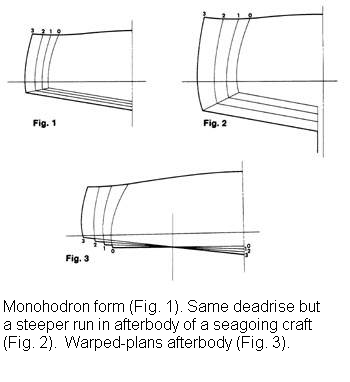This is the first in a three-part survey on powerboat hull design. Reprinted from the March 1979 Motor Boating and Sailing
If you have a modem power cruiser, chances are shes a standard deadrise V-bottom type, not a deep-V (for true deep-Vs have deadrise angles of about 18 or more) but a moderate sectioned planing hull. There are many variations on the V-bottom theme, but most designs have several major principles in common.
The warped plane
If a design were to carry a uniform angle of deadrise throughout the length of its bottom, and if that angle were flat enough to be efficient in a planing attitude, it is obvious that the forward sections would be too flat for all but the smoothest sea conditions. It is for this reason that designers have warped the forward sections of the bottom, creating a deeper forefoot and drastically more deadrise at the boats entry. As the sections of such a vessel move aft, the bottom gradually flattens out in order to retain the planing efficiency of the broad, low-deadrise angle.
It is critical, however, where the flattening occurs. Most designers agree that the best place is at the widest part of the load waterplane – that is, the place where the waterline beam is greatest. At this spot, the sections describing the bottom will warp or cross over to a shallower attitude, and remain (ideally) at a constant deadrise angle all the way to the transom.
If the warp is too drastic, or if the crossing of the sections occurs at the central area of the bottom, water action forms a pocket or air space under the hull and the boat will try to squat into the space, thereby creating a force that will work against planing.
This suction is best eliminated by: 1) warping the bottom gradually from the forefoot aft, 2) seeing that the sections involved in the warp or twist cross each other either outboard at the chine or inboard at the keel (thereby avoiding the large pocket formed when the warp centers in the middle of the bottom area) or 3) forming the warp at the widest possible portion of the boat.
The monohedron principle A boat with after sections that are parallel all the way to the transom is said to have a monohedron afterbody. Most designers will agree that this parallelism helps sustain a smooth, consistent waterflow all the way back along the run, avoiding suction and turbulence that can be caused by further warping of the bottom. Figure 3 shows a warped afterbody-one that will cause just the kind of suction were talking about. The idea is to stick to the parallelism shown in the two other illustrations.
A boat with after sections that are parallel all the way to the transom is said to have a monohedron afterbody. Most designers will agree that this parallelism helps sustain a smooth, consistent waterflow all the way back along the run, avoiding suction and turbulence that can be caused by further warping of the bottom. Figure 3 shows a warped afterbody-one that will cause just the kind of suction were talking about. The idea is to stick to the parallelism shown in the two other illustrations.
Gull-winging
When a bottom has convex sections along its length, it is said to have a gullwing shape. This shape allows for a deeper deadrise toward the point where the section attacks the water – i.e., the keel. This quality simply causes a slight deflection as the boat slams into a chop, absorbing the energy that would otherwise be transmitted to the passengers.
The profile
It has been said that a hull must not sweep upward toward the transom if it is to be a good planing performer. This means that the buttocks, fairbody, and chines must run aft in as straight and flat an attitude as possible. With this configuration, the afterbody will part from the water cleanly and smoothly, creating little turbulence and its resultant suction. Some boats carry this principle to an extreme by wedging (getting fuller in volume all the way to the transom).
But, most multipurpose Vs tend to compromise on this count, employing some upward sweep of the buttocks for good displacement performance and sea-keeping ability. Indeed, something is always compromised to some degree-but how well a boat performs in a variety of conditions is an indication of how well a naval architect understands the subtleties of V-bottom design. -Doug Schryver

